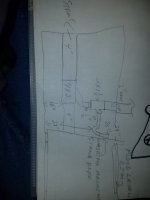jaywalsh31
New Member
Hello, everyone my name is Jason. I was hoping i could pick some brains about a clothes washer that is installed in massachusetts. I checked the forum for mass but no one goes there so I'm trying my luck here.
Problem: washing machine was full of water and overflowing onto the floor. The standpipe was only 8" long. Second problem I noticed is the washing machine is in the basement and the 4" horizontal main drain pipe is about 21" off the floor where the washer is and cannot be lowered. (See terrible art work for reference). There is a 4x2" wye on the horizontal main that serves the washing machine and the outlet faces up. Clown town put a 2 x1 1/2" bushing into it followed by a 1-1/2" 45 and then directly into another bushing bringing it back too 2" followed by a 2 x 1 -1/2" tee wye. 2" continues up for vent and the Washing machine trap sits at about 21" off the floor. Making the stand pipe about 26" off the floor. Flood level rim of washer is about 3" above stand pipe at 29".
My question is WHY is the maximum height for the trap 18" ? I believe its so that the washer does not end up full of water but am I missing something? the washer flood level rim was about 3" above the stand pipe by visual inspection. I since brought it up over the F.L.R. about 7" . My best guess is the main drain not having a back water valve on it was flooded with rain water from neighbor's not having their storm and sewer separated. The house is in a flood zone and it was raining. Gravity draining from the sewer line into the washer? But flooding over the washer and soaking the floor? It was definetly not the washer acting up, it was off and empty. I am going to put a 4" backwater valve on the main but i am concearned. What if the sewer backs up again and the 6 tenents and there familias are flushing and showering. The pressure from the street has the backwater closed. Over powering the tenants. The first fixture is the washer stand pipe. Does the basement flood or do I put a backwater on the laundry also? Or do i cap the laundry and install a sewer ejector pump? If anyone can help me on suggestions, I would appreciate it.
One more question if you can please bare with me. When tieing in a laundry In massachusetts. I was taught to make the laundry the first or last fixture on the main with at least 10' of pipe separating it from any other branch. Did I understand this correctly? I can't find it in the big book. Purpose being I'm assuming first is not getting a back up into the laundry or onto the floor and second the suds issue where customer or neighbor uses to much soap and it suds up out of the stand and onto the floor. Thanks guys.
Problem: washing machine was full of water and overflowing onto the floor. The standpipe was only 8" long. Second problem I noticed is the washing machine is in the basement and the 4" horizontal main drain pipe is about 21" off the floor where the washer is and cannot be lowered. (See terrible art work for reference). There is a 4x2" wye on the horizontal main that serves the washing machine and the outlet faces up. Clown town put a 2 x1 1/2" bushing into it followed by a 1-1/2" 45 and then directly into another bushing bringing it back too 2" followed by a 2 x 1 -1/2" tee wye. 2" continues up for vent and the Washing machine trap sits at about 21" off the floor. Making the stand pipe about 26" off the floor. Flood level rim of washer is about 3" above stand pipe at 29".
My question is WHY is the maximum height for the trap 18" ? I believe its so that the washer does not end up full of water but am I missing something? the washer flood level rim was about 3" above the stand pipe by visual inspection. I since brought it up over the F.L.R. about 7" . My best guess is the main drain not having a back water valve on it was flooded with rain water from neighbor's not having their storm and sewer separated. The house is in a flood zone and it was raining. Gravity draining from the sewer line into the washer? But flooding over the washer and soaking the floor? It was definetly not the washer acting up, it was off and empty. I am going to put a 4" backwater valve on the main but i am concearned. What if the sewer backs up again and the 6 tenents and there familias are flushing and showering. The pressure from the street has the backwater closed. Over powering the tenants. The first fixture is the washer stand pipe. Does the basement flood or do I put a backwater on the laundry also? Or do i cap the laundry and install a sewer ejector pump? If anyone can help me on suggestions, I would appreciate it.
One more question if you can please bare with me. When tieing in a laundry In massachusetts. I was taught to make the laundry the first or last fixture on the main with at least 10' of pipe separating it from any other branch. Did I understand this correctly? I can't find it in the big book. Purpose being I'm assuming first is not getting a back up into the laundry or onto the floor and second the suds issue where customer or neighbor uses to much soap and it suds up out of the stand and onto the floor. Thanks guys.

